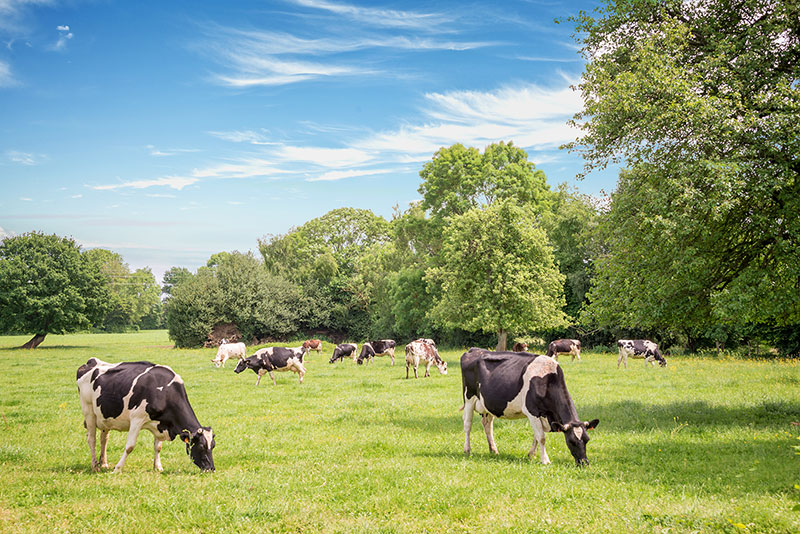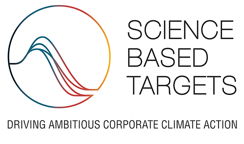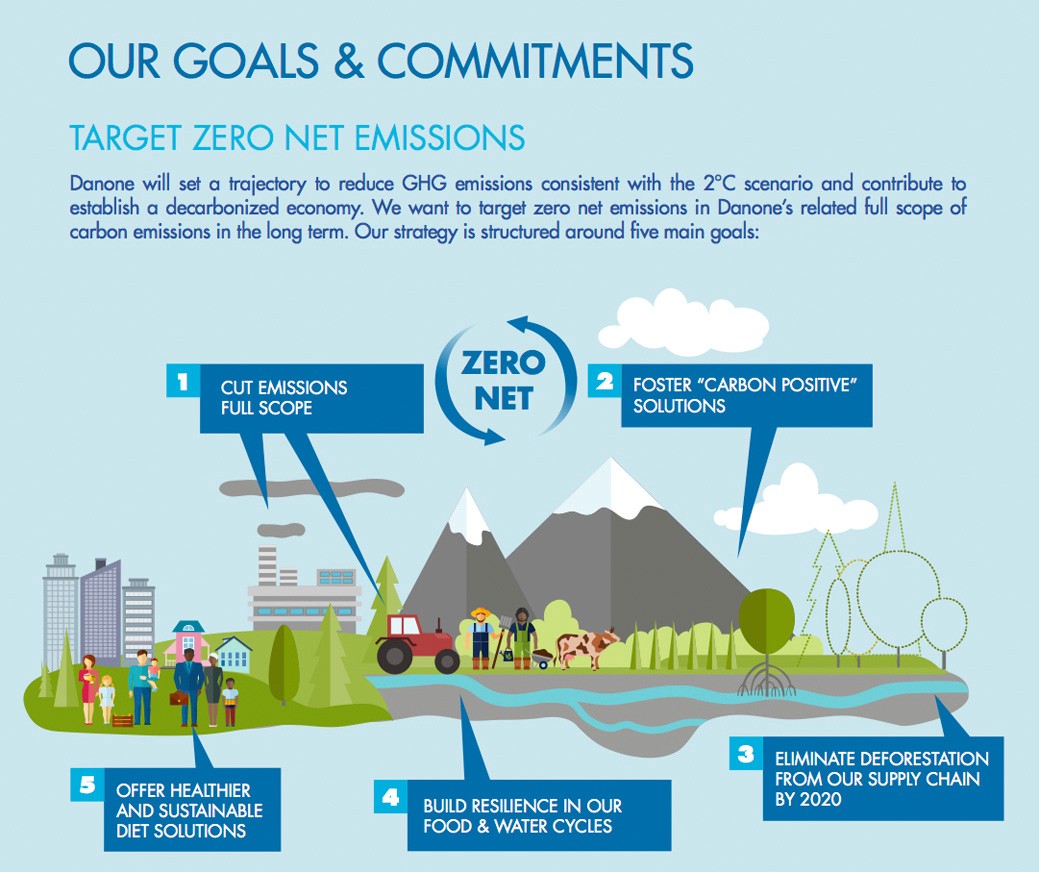Danone embraces ambition in push for carbon neutrality
We Mean Business coalition
INTRODUCTION
 Danone is one of the world’s leading food companies and the global leader in dairy. Globally it is a €25 billion ($29.3 billion) turnover business, with around 100,000 employees operating in more than 120 countries. Eric Soubeiran, Danone’s Global Nature and Climate Director, spoke to us from the company’s Paris headquarters.
Danone is one of the world’s leading food companies and the global leader in dairy. Globally it is a €25 billion ($29.3 billion) turnover business, with around 100,000 employees operating in more than 120 countries. Eric Soubeiran, Danone’s Global Nature and Climate Director, spoke to us from the company’s Paris headquarters.
The Targets
Danone is committed to transitioning to 100% of global electricity consumption from renewable sources with RE100, led by The Climate Group in partnership with CDP. Danone is also committed to removing commodity-driven deforestation from all supply chains by 2020, improving water security, and has an approved science-based target.
Danone is committed to becoming carbon neutral across its full value-chain by 2050. Danone is also committed to reach peak emissions in volume terms before 2025, which means decoupling volume growth from carbon emissions.
In 2017, the full scope of Danone’s related greenhouse gas (GHG) emissions amounted to 21.6 million tons, 93.2% of which comes from Scope 3. Achieving the carbon neutral target will be equivalent to taking some 5 million typical passenger vehicles off the road for one year.
As part of its journey towards carbon neutrality, Danone set intermediate carbon reduction targets for 2030, from a 2015 baseline:
- to reduce scope 1, 2 and 3 emission intensity, per ton of sold product, by 50%.
- to achieve a 30% absolute reduction of scope 1 and 2 emissions.
The company’s 2030 targets were approved by the Science Based Target initiative (SBTi).
What action have you taken to deliver against these climate commitments?
To be carbon neutral by 2050 means we need to change and adapt our entire business, embedding our climate targets into our business processes. Our environmental monitoring team, which includes finance experts, go through a very granular exercise, business by business, to identify key projects that can drive us towards these targets.
Take evian, our flagship natural mineral water brand. evian has reduced its industrial energy consumption by 23% per liter produced between 2008 and 2016. And in 2017, we unveiled a carbon neutral, 130 square kilometre, evian bottling site. The site is 100% powered by renewable energy and buys electricity only from the nearby hydro-electric power plant. It also has an onsite private railway station, meaning that the bottles can be shipped directly onto train freight (which has a carbon footprint ten times lower than road transport). Today, 60% of evian bottles are shipped by train, and we’re aiming to increase this figure in the coming years.
The evian factory is situated in the Plateau de Gavot, where many farmers produce milk to make cheese. Their farming practices have a direct impact on the quality of our water. To ensure that farming is done in a way that preserves the health of the catchment area, we teamed up with farmers and other members of the community to launch the Terragr’Eau methanizer in 2016. Each year, the methanizer converts 40,000 tons of organic waste into natural fertilizer used by local farmers, while producing biogas to provide power for 1,200 inhabitants—equal to the annual gas consumption of evian’s bottling site. It’s an example of how connected the issues of water, agriculture and carbon are, and how we can address them in a holistic way.
We work with 140,000 farmers globally, so Danone understands the complexity of Scope 3 supply chain emissions. As part of the Cool Farm Alliance, we use the Cool Farm Tool to quantify our carbon footprint at farm level. In France, we have committed to reducing our farmers’ carbon intensity (CO2 per kilogram of product) by 15% by 2025. To do this, we have worked with farmers on their crop rotation strategy, tillage, cover cropping, animal feed, all of which can reduce the carbon emissions at farm level.
Our carbon sequestration initiative in North America, in partnership with Cornell University and Ohio State University, also focuses on how we might work with farmers to protect soil quality and sequester carbon from the atmosphere back into the soil. The capacity of the soil to sequester carbon (via photosynthesis) is very different depending on the crop you have, the coverage and rotation. When you have a footprint like Danone that amounts to 1.5 million hectares of growing land, which is half the size of Belgium, the capacity to enhance sequestration is substantial.
ARE YOU GOING FURTHER AND FASTER?
Right now we are in line with our targets. We reduced carbon intensity, full scope, by 10.5% over 2016 and 2017. In 2008, Danone set the goal of reducing its carbon intensity by 30% (excluding agriculture) by 2012 – a goal we more than met. In 2013, we reaffirmed this commitment by announcing a new target for a 50% reduction of carbon intensity by 2020 – we met this in 2016. Our goal now, to again reduce carbon intensity by 50% by 2030, is much more ambitious, given the reductions we have already made.
WHAT STRATEGIES ARE YOU TAKING TO IMPLEMENT THE TARGETS?
The strategy has changed in recent years – perhaps five years ago the focus on Scope 3 was not as intense. Our evian factory is a flagship, but our factory emissions amount to just 10% of our total emissions. Our strategy now is to work closely with the agricultural supply chain, to develop relationships and move towards regenerative practices that will strengthen carbon sequestration, biodiversity, and water quality. Together with our partners, we are creating a movement.
WHAT ARE THE BENEFITS TO THE COMPANY OF HAVING EMISSIONS TARGETS?
You get to know who you are – you understand the impact of your business. When you talk about optimizing your energy consumption, reducing your fuel consumption – you are talking about cost savings. When you talk about Scope 3, it is about regenerative practices that make our supply chain more resilient while meeting consumer demand for naturality and sustainable ingredients. When you move from traditional farming practices to organic, you see a reduction in productivity of about 20%, so your cows will produce about 20% less milk. But after a few years, you have the benefit of being able to sell at a higher price, using significantly less inputs. This offers a better livelihood for farmers and creates a supply chain that is more resilient and less exposed to volatility.
ARE THERE ANY BENEFITS TO THE LOCAL OR NATIONAL ECONOMY?
When you change your practices – reduce fertilizer, improve soil health, improve water retention – then you protect the natural capital for communities. Together with nine other companies, Danone developed an impact investment vehicle called the Livelihoods Carbon Fund, which funds projects to enhance the livelihood of communities while generating carbon positive action. The Livelihoods Fund has, for example, developed large-scale mangrove restoration projects in Senegal, Indonesia and India. In Senegal, the 80 million mangrove trees that have been replanted harbor more fish, and farmers are now able to grow rice on lands previously degraded by sea water. It shows how much potential carbon positive actions have in terms of broader economic development.
WHAT POLICIES WOULD MAKE ACHIEVING THE TARGETS EASIER?
There is a big debate about how you can monetize the multiple benefits of carbon action. Putting a price on carbon could help, but another important element is protection from risk. For instance, converting to green energy requires investment. Green energy manages to be competitive in terms of price because governments secured the uptake of green energy and secured the capacity of the financial sector to invest. If you do that, you have a virtual cycle: the energy user guarantees the uptake, the bankers finance it, and the government reduces the risk to an acceptable level so that the financing cost is not too expensive. Without that, private companies must pre-finance, guarantee the uptake, and take the risk. That’s where the role of government lies. Fixing the price of carbon is about taxation – that is the stick. But we need big policies to act as the carrot – this could be regulations that de-risk carbon positive investment, incentivize financial markets. What we need is the de-risking element, the incentives that governments could foster.
WHAT WIDER IMPACT DOES COMPANIES HAVE BY MAKING SUCH COMMITMENTS?
The We Mean Business coalition has created a positive dynamic by saying that business can be part of the solution. I think that sometimes being for something is more effective than being against. And we know that the commitments we are taking through this collective process will make a difference in the end. That’s why initiatives like RE100 are powerful – they inspire companies like ours to go one step further. As a food company, we want consumers to know that, by buying Danone, you are contributing to the solution. Our conviction is that each time you eat and drink, you vote for the world you want to live in.



